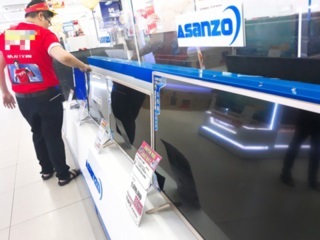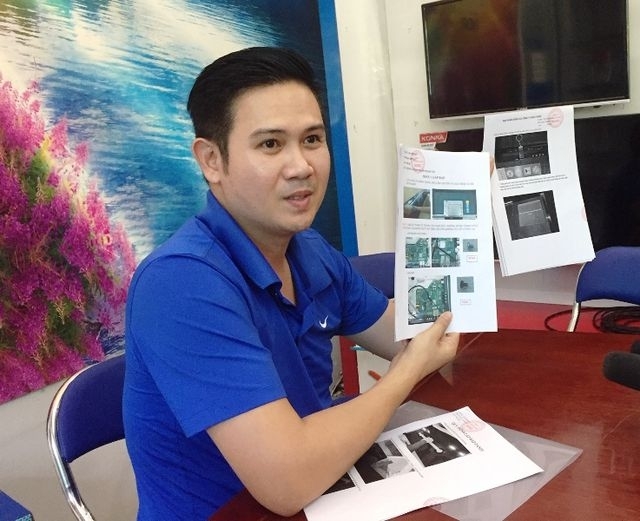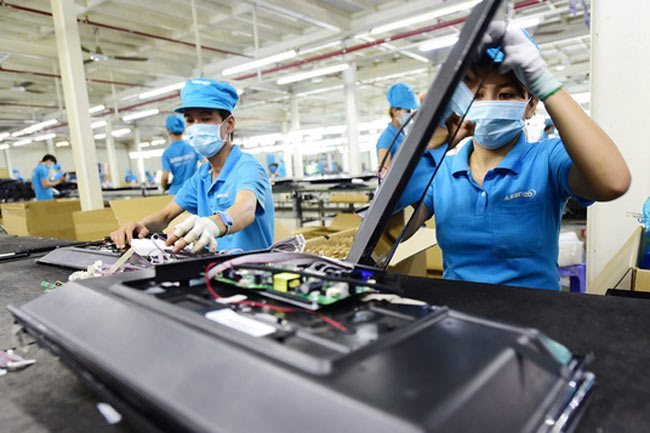 |
| Pham Van Tam, chairman of Asanzo Vietnam, inspects a TV screen – PHOTO: VIETNAMNET |
Trung told the participants of a roundtable talk in Hanoi today, July 17, that Vietnam is a signatory to both the ASEAN Trade in Goods Agreement (ATIGA) and the ASEAN-China Free Trade Agreement (ACFTA).
If a local firm imports all materials from China for simple assembly, those products cannot be labeled “Made in Vietnam,” based on the regulations of the ATIGA, he explained.
However, taking the ACFTA regulations into account, these products could be seen as originating from Vietnam since all the materials imported from other state members, including China, could be seen as Vietnam-made products if the final stage of production was completed in the country.
“This is a difficult issue. Management agencies may not have enough resources to assess the root of the problem,” he remarked, adding that the rules of origin in many countries are also significantly different.
He pointed out that local producers and importers have the right to self-declare the origins of their products, based on prevailing regulations or trade pacts signed by Vietnam.
An official from the Ministry of Industry and Trade told a press briefing early this month that the labeling of the origins of goods is being carried out in accordance with the Government’s Decree 43/2017 on the labeling of goods.
The decree requires all goods in Vietnam to be labeled with mandatory details, including the names of the producers and traders and the origin of the product.
It also stipulates that product distributors must research the information needed for their labels and take responsibility for recording the origins of goods.
As such, the decree stipulates the contents of labels, but it fails to specify the criteria for a “made in Vietnam” label.
According to the official, Vietnam has also engaged in many trade pacts that have regulations on goods that enjoy preferential tariffs but have no regulations for brands on the domestic market.
The ministry admitted that Vietnam’s laws have no clear regulations on country of origin labeling for goods made in Vietnam. Currently, regulations are issued to suit practical conditions affecting production and trade in Vietnam since most address geographical indications, commodity labels and trademarks.
Bui Kim Thuy, the country representative for Vietnam at the U.S.-ASEAN Business Council, noted that while the trade ministry has yet to issue laws on the identification of Made-in-Vietnam goods, firms with production lines in the country are not breaking the law by labeling their goods as home-made.
“The issue of concern is how the consumer assesses the quality of the products,” she said.
Asanzo Vietnam, as covered in the local media, has imported electronic items from China – either components or finished products – for the past five years. It then assembles them or simply attaches Made-in-Vietnam labels to the products before selling them on the local market.
The company’s TV products alone hold a market share of some 15%, while its revenue target for this year is pegged at VND10 trillion, or some US$430 million. SGT
Thuy Dung

Retailers take Asanzo’s products off shelves
Retailers have taken Asanzo-branded items off their shelves after Asanzo Viet Nam Electronics JSC was accused of selling products imported from China as 'Made in Vietnam' goods.

PM requests investigation into Asanzo’s alleged faked made-in-Vietnam products
PM Nguyen Xuan Phuc has requested the Ministry of Finance and other government agencies to verify whether electronics firm Asanzo has been selling Chinese goods disguised as made-in-Vietnam, local media reported.

Asanzo discovered selling Chinese products bearing made-in-Vietnam labels
Electronic products from Asanzo Vietnam, known as an electronics manufacturer supplying high-quality Vietnamese products in the local market, have been discovered to be Chinese goods being sold as Vietnamese products.
 Given the varying criteria and rules on origins, it is possible that local electronics producer Asanzo Vietnam had legally identified its products as “Made in Vietnam,” said lawyer Tran Ngoc Trung from law firm Baker & Mckenzie Vietnam.
Given the varying criteria and rules on origins, it is possible that local electronics producer Asanzo Vietnam had legally identified its products as “Made in Vietnam,” said lawyer Tran Ngoc Trung from law firm Baker & Mckenzie Vietnam.